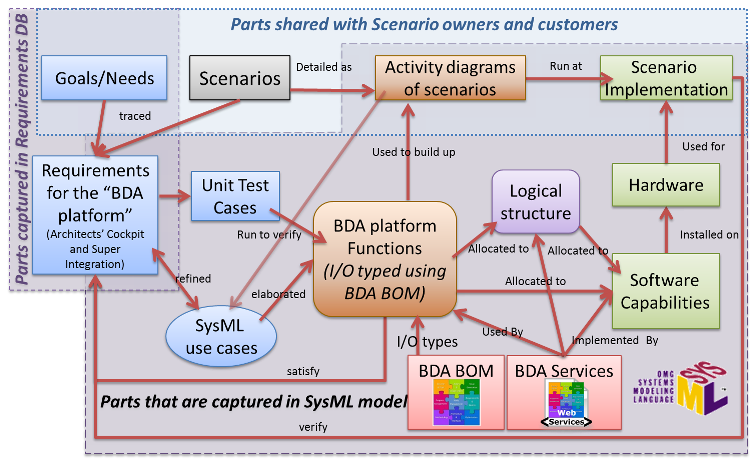Understanding SysML¶
Why are we using SysML?¶
omgsysml.org describes SysML as this:
The OMG systems Modelling Language (OMG SysML) is a general-purpose graphical modelling language for specifying, analysing, designing, and verifying complex systems that may include hardware, software, information, personnel, procedures, and facilities.
That is a good description of SysML, however, the benefits of SysML are not mentioned. Specific benefits that an evolving SysML model can bring to a project are listed below:
- Consolidated end-to-end definition with MBSE approach
- Auto generation of deliverable content
- Persistence post project
- Information for promoting the relevant standards
Using SysML in conjunction with MBSE¶
SysML would be used to capture information in a model based Systems Engineering (MBSE) project.
Taking this approach enables the capture of:
- Requirements /Operational Analysis
- How they are implemented in functions
- Who implements the functions
- Functional Analysis
- Functional specification
- Declare the usage of methods
- Understand where methods are used
- Logical (Architecture) definition
- The logical structure
Physical Definition
- For each scenario:
- Installed Capability/functionality
- Installed Software
- Which Requirements to verify
The image below relates to the above list. Requirement analysis elements are shown in blue, functional analysis in brown , logical structure in purple and physical definition objects are shown in green. The image shows how the elements in an MBSE project are linked together and how they feed back to the beginning of the process to ensure verification that the requirements have been satisfied. The aspect of this process that can be captured in SysML is identified as being on an orange background.
Who uses the Model¶
- Scenario Owners:
- See how they are implemented
- See requirement verification
- Software Solution Providers:
- Specifications of functions that are to be implemented in software
- Shows where software is used in scenarios
- Demonstration Organisers:
- Define where each software solution is to be installed
SysML Useful Links¶
| Name | Reference | Type | Description |
|---|---|---|---|
| OMG SysML home page | http://www.omgsysml.org/ | website | Home page for OMG SysML. It includes links to downloads, papers, presentations, articles, and books (including Friendenthal below). |
| ISO/IEC 15288 home page | http://www.iso.org/iso/catalogue_detail?csnumber=43564 | website | ISO/IEC 15288:2008 Systems and software engineering – System life cycle processes |
| A Practical Guide to SysML, Second Edition: The Systems Modeling Language (The MK/OMG Press) [Sanford Friedenthal, Alan Moore, Rick Steiner] | ISBN 978-0-12-385206-9 | Book | The book includes a full description of the modelling language along with a quick reference guide, and shows how an organization or project can transition to model-based systems engineering using SysML, with considerations for processes, methods, tools, and training. Numerous examples to help readers understand how SysML can be used in practice. |
| Model Based Systems Engineering pages of the INCOSE MBSE Challenge teams | http://mbse.gfse.de/index.html | www | A website introducing MBSE, and has a detailed SysML work example of a telescope using Magicdraw |
